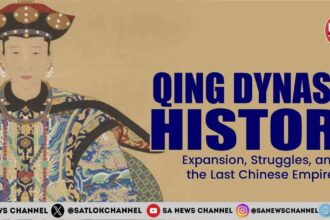The Crusades were a series of religious wars fought between Christians and Muslims during the medieval period, primarily over control of the Holy Land. Spanning from 1096 to 1291, these conflicts shaped the political, religious, and cultural landscapes of Europe and the Middle East. This article explores the history of the Crusades, their causes, major campaigns, and enduring impact.
- What Were the Crusades?
- Causes of the Crusades
- Timeline of the Crusades
- Fourth Crusade (1202–1204)
- Later Crusades (13th Century)
- Fall of the Crusader States (1291)
- Key Figures in the Crusades
- Impact of the Crusades
- The Crusades and Modern Perspectives
- Lessons from the Crusades
- The Legacy of the Crusades
- FAQs about the history of the Crusades
- Spiritual Perspective The True Essence of Religion
What Were the Crusades?
The Crusades were military expeditions initiated by the Roman Catholic Church. They were framed as a religious duty for Christians, with the promise of spiritual rewards. The term “Crusade” derives from the Latin word crux, meaning cross, symbolizing the religious nature of these wars.These campaigns were not limited to the Holy Land but also included wars in Spain (Reconquista), campaigns in the Baltic region, and even internal Christian conflicts. However, the focus of the Crusades remained the struggle for Jerusalem, a city sacred to Christians, Muslims, and Jews.
Causes of the Crusades
1. Religious Motivations:
The Crusades were primarily fueled by the desire to secure access to Jerusalem and other holy sites for Christian pilgrims. The Muslim control of these areas and reports of pilgrim mistreatment heightened tensions.
2. Political Factors:
The decline of Byzantine power after the Battle of Manzikert (1071) and the rise of the Seljuk Turks prompted Byzantine Emperor Alexios I Komnenos to seek help from the West.
3. Economic Incentives:
For European knights and nobles, the Crusades offered opportunities for wealth, land, and trade in the East. Merchants also supported the campaigns to gain access to lucrative trade routes.
4. Papal Ambitions:
Pope Urban II saw the Crusades as a way to unite Christendom under the Church’s authority, strengthen its influence, and resolve internal conflicts among European nobility.
Timeline of the Crusades
First Crusade (1096–1099)
The First Crusade began after Pope Urban II’s call to arms at the Council of Clermont in 1095. It was a resounding success for the crusaders, resulting in the capture of Jerusalem in 1099 and the establishment of several crusader states, including the Kingdom of Jerusalem.
Second Crusade (1147–1149)
This Crusade was launched in response to the fall of Edessa, one of the crusader states, to Muslim forces. Led by European kings like Louis VII of France and Conrad III of Germany, the campaign failed to achieve its objectives.
Third Crusade (1189–1192)
Known as the “Crusade of Kings,” this campaign featured prominent leaders such as Richard the Lionheart of England, Philip II of France, and Frederick Barbarossa of the Holy Roman Empire. Although they recaptured important cities like Acre, they failed to reclaim Jerusalem from Saladin, the sultan of Egypt and Syria.
Fourth Crusade (1202–1204)
Initially intended to conquer Muslim-held Jerusalem, the Fourth Crusade deviated from its goal, leading to the sack of Constantinople, a Christian city. This event deepened the schism between the Eastern Orthodox and Roman Catholic Churches.
Later Crusades (13th Century)
The Fifth, Sixth, and Seventh Crusades focused on regaining lost territories but had limited success. By the time of the Eighth Crusade (1270), enthusiasm for the cause had waned.
Fall of the Crusader States (1291)
The fall of Acre in 1291 was a pivotal moment in history as it marked the collapse of the last significant Crusader stronghold in the Holy Land. Acre, located in modern-day Israel, had served as a strategic and economic hub for the Crusader states. Its loss to the Mamluks not only ended Christian territorial control in the region but also signaled the conclusion of nearly two centuries of Crusading efforts.
Also Read: Roman Empire History Revealed: From Mythical Beginnings to Lasting Impact
The defeat highlighted the dwindling resources and fragmented alliances among the Crusaders, as well as the growing strength and unity of Muslim forces under leaders like Sultan al-Ashraf Khalil. After Acre’s fall, the remaining Crusader presence retreated to Cyprus, effectively ending the era of large-scale Christian campaigns in the Holy Land. This event underscored the limitations of using military force in the name of religion and serves as a historical reminder of the consequences of religiously motivated conflicts.
Key Figures in the Crusades
1. Pope Urban II:
His call to arms in 1095 was the catalyst for the First Crusade.
2. Saladin:
The Muslim leader who united the Islamic world and recaptured Jerusalem in 1187.
3. Richard the Lionheart:
An iconic figure of the Third Crusade, known for his military prowess and negotiations with Saladin.
4. Godfrey of Bouillon:
A leader of the First Crusade, he became the first ruler of the Kingdom of Jerusalem.
5. Frederick Barbarossa:
The Holy Roman Emperor who died en route to the Holy Land during the Third Crusade.
Impact of the Crusades
1. Cultural Exchange:
The Crusades facilitated the exchange of ideas, goods, and technologies between East and West. Europeans were introduced to advancements in medicine, mathematics, and navigation from the Islamic world.
2. Religious Consequences:
The Crusades intensified animosity between Christians and Muslims, with effects that resonate even today. They also strained relations between the Roman Catholic and Eastern Orthodox Churches.
3. Political Shifts:
The Crusades weakened the feudal system in Europe, as many nobles sold their lands to fund their campaigns. This contributed to the rise of centralized monarchies.
4. Economic Growth:
Increased trade with the East enriched European cities, especially Venice and Genoa, which became prominent trading hubs.
5. Military Developments:
Techniques and strategies developed during the Crusades influenced European warfare, including the use of fortified castles and siege tactics.
The Crusades and Modern Perspectives
Modern historians view the Crusades through a critical lens, acknowledging their complex motivations and outcomes. While they were framed as religious missions, they were often driven by political and economic ambitions.
The brutal massacres of Muslims, Jews, and even fellow Christians during these campaigns are widely condemned. The Crusades also highlight the dangers of religious fanaticism and the misuse of faith for political ends.
Lessons from the Crusades
1. Interfaith Relations:
The Crusades underscore the importance of dialogue and understanding among different religions.
2. Cultural Integration:
The exchange of knowledge during the Crusades shows the value of cultural interaction in advancing human progress.
3. Historical Awareness:
Studying the Crusades helps us understand the complexities of history and the interplay between faith, politics, and economics.
The Legacy of the Crusades
The history of the Crusades is a story of ambition, faith, and conflict. While they failed to achieve their ultimate objective of securing long-term Christian control over the Holy Land, their impact on history is undeniable. From cultural exchanges to political shifts, the Crusades played a pivotal role in shaping medieval Europe and the Middle East. Understanding this era offers valuable insights into the complexities of human history and the lessons we can draw for fostering a more harmonious world.
FAQs about the history of the Crusades
1. What were the main goals of the Crusades?
The primary goal was to reclaim Jerusalem and other holy sites from Muslim control. Secondary goals included defending the Byzantine Empire and spreading Christianity.
2. How many Crusades were there?
Historically, there were eight major Crusades, although smaller campaigns were also launched.
3. Why did the Crusades fail?
The Crusades ultimately failed due to poor planning, internal divisions among European forces, and the resilience of Muslim leaders like Saladin.
4. What was the legacy of the Crusades?
The Crusades left a mixed legacy, including cultural exchanges, economic growth, and enduring religious tensions.
5. What was the primary long-term impact of the Crusades on Europe and the Middle East?
The Crusades facilitated cultural exchanges, trade expansion, and political shifts that shaped medieval Europe and the Middle East.
Spiritual Perspective The True Essence of Religion
The Crusades (1096–1291), fought between Christians and Muslims over the Holy Land, reflect a misuse of religion for political and territorial gain. Bakhabar/Saint/ Chyren/Messiah/Spiritual Leader Sant Rampal Ji Maharaj’s teachings highlight that true religion is about connecting with the Supreme God, following His prescribed method of worship, and attaining salvation.
Unlike the violence and division seen in the Crusades, Sant Rampal Ji emphasizes peace, love, and non-violence. Holy scriptures, such as the Bible and the Quran, teach compassion, peace, and respect for all beings, yet these principles were overshadowed by the Crusaders’ actions driven by power and greed.
Sant Rampal Ji Maharaj explains that spiritual ignorance leads to conflicts like the Crusades. True spirituality, as prescribed in the holy texts, involves worshipping the one Supreme God, not using religion as a weapon of division. The teachings of Sant Rampal Ji and the scriptures emphasize that religion should unite humanity, not lead to war.
The Crusades serve as a reminder of the consequences of straying from true spiritual knowledge. By following the true path of worship and understanding the divine message of peace, humanity can move beyond religious conflicts and work towards unity and eternal salvation.
Sant Rampal Ji emphasizes
Our race is living being, Humanity is our Religion. Hindu, Muslim, Sikh, Christian, there is no separate Religion. – Sant Rampal Ji Maharaj.
By spreading this message, Sant Rampal Ji seeks to inspire a society where people live harmoniously, respecting each other as equals, and focusing on true spiritual devotion.
Watch His Spiritual Discourses on Sant Rampal Ji Maharaj Youtube Channel









